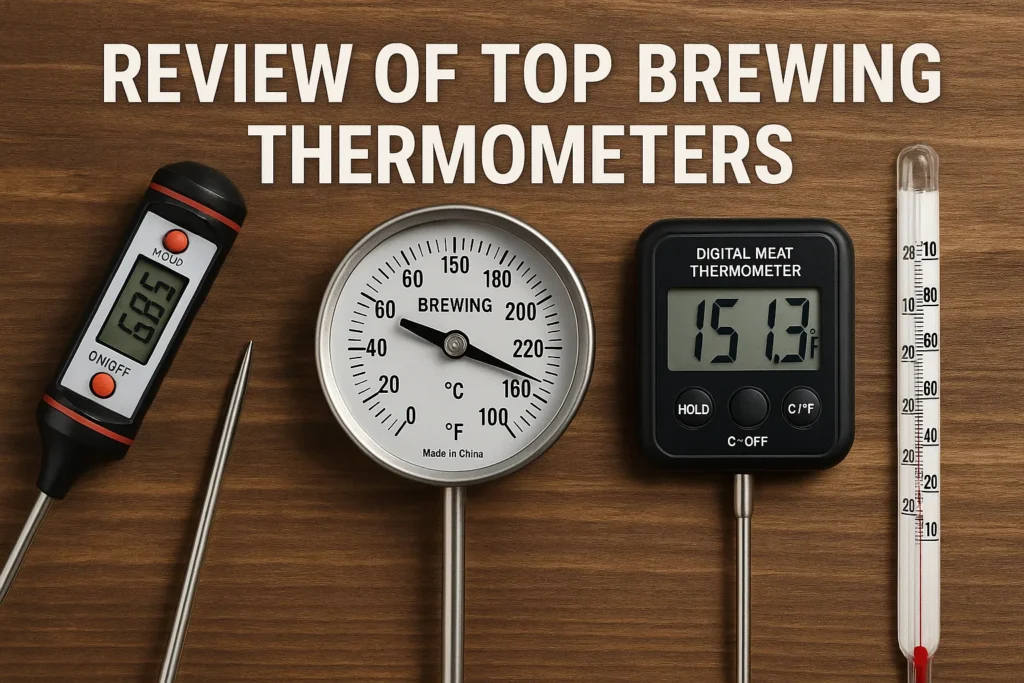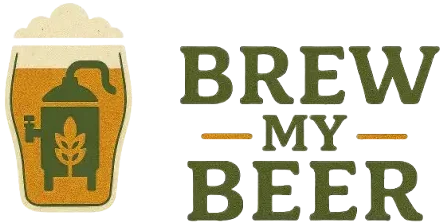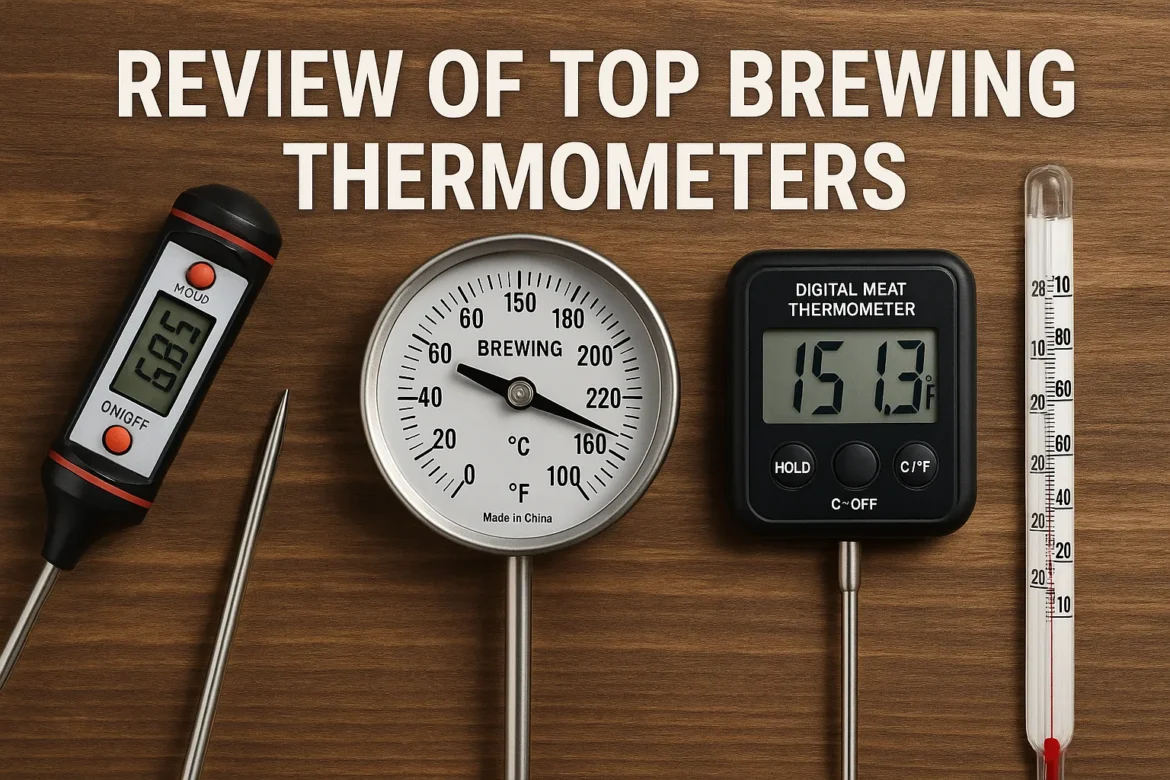Temperature Control for Exceptional Beer Discover the best brewing thermometers for perfect homebrewing. Compare digital vs analog, accuracy, features, and top-rated models to ensure precise temperature control for exceptional beer quality.

Temperature control stands as one of the most critical aspects of successful homebrewing, directly influencing enzyme activity, extraction efficiency, and final beer quality. Professional brewers understand that even minor temperature variations can dramatically alter the brewing process, affecting everything from mash conversion to fermentation outcomes. Whether you’re a beginner exploring extract brewing or an advanced all-grain brewer managing complex temperature schedules, selecting the right brewing thermometer becomes essential for consistent, high-quality results.
Modern brewing thermometers offer unprecedented accuracy and convenience compared to traditional glass floating thermometers, with digital models providing readings within seconds and analog dial thermometers offering reliable, calibratable performance. The choice between different thermometer types depends on your brewing setup, accuracy requirements, and budget considerations.
Understanding Different Types of Brewing Thermometers
Digital Instant-Read Thermometers
Digital instant-read thermometers represent the pinnacle of brewing temperature measurement technology, offering rapid response times and exceptional accuracy. These sophisticated instruments typically provide temperature readings within 1-4 seconds, making them ideal for quickly checking mash temperatures, monitoring sparge water, and verifying cooling wort temperatures.
The ThermoWorks Thermapen series stands as the gold standard among digital brewing thermometers, with the Thermapen ONE delivering readings in under one second with ±0.5°F accuracy. Professional brewers and serious homebrewing enthusiasts consistently recommend these instruments for their reliability and precision. The device features a large, backlit display that remains easily readable in various lighting conditions, while the waterproof construction ensures durability during intensive brewing sessions.
For budget-conscious brewers, the Lavatools PT12 Javelin offers impressive performance at a more accessible price point, providing 3-4 second readings with ±0.9°F accuracy. This thermometer features automatic on/off functionality when the probe extends or retracts, plus a convenient magnetic back for storage on metal surfaces. However, users should note that the shorter probe length requires careful handling around hot surfaces.
Analog Dial Thermometers
Analog dial thermometers remain popular among homebrewers for their durability, simplicity, and ability to provide continuous temperature monitoring without battery dependence. These instruments typically feature large, easy-to-read faces with dual-scale markings in both Fahrenheit and Celsius.
The 12-inch Dial Thermometer from Home Brew Ohio exemplifies quality analog design, featuring a substantial 12-inch probe that reaches deep into brewing vessels while the adjustable clip securely attaches to kettle rims. The large dial face provides clear temperature readings from 0-220°F in 2-degree increments, making it suitable for all brewing applications from mashing to boiling.
Bayou Classic Brew Thermometers offer permanent installation options for dedicated brewing setups, mounting directly through kettle walls with threaded NPT fittings and O-ring seals. These thermometers provide constant temperature monitoring without requiring manual insertion, though they limit vessel flexibili
Infrared Non-Contact Temperature Control for Exceptional Beer
Infrared thermometers offer unique advantages for specific brewing applications, measuring surface temperatures without physical contact. These devices work by detecting thermal radiation emitted by objects, with an integrated laser providing precise aiming assistance.
While infrared thermometers excel at monitoring kettle external temperatures, fermenter surfaces, and heating element conditions, they face significant limitations with brewing liquids. Foam, grain particles, and steam interference commonly affect accuracy when measuring mash temperatures or boiling wort. Additionally, these instruments only measure surface temperatures, potentially missing internal temperature variations crucial for brewing processes.
Specialty Thermometers
Fermometer Adhesive Strip Thermometers provide economical fermentation monitoring through liquid crystal technology that changes color based on temperature ranges. These strips attach to fermentation vessel exteriors, displaying suggested temperature ranges for various beer and wine styles. While not suitable for mash or boil monitoring, they offer convenient fermentation tracking without sanitation concerns.
Bluetooth-Enabled Thermometers like the Blichmann BrewVision represent cutting-edge brewing technology, transmitting temperature data directly to smartphone applications. These systems enable remote monitoring during long mash steps, allowing brewers to manage other tasks while maintaining temperature oversight. The BrewVision offers ±0.5°F accuracy and integrates with recipe management software for comprehensive brewing documentation.
Key Features to Consider When Choosing Brewing Thermometers
Accuracy and Precision Requirements
Temperature accuracy directly impacts brewing success, with different brewing stages requiring varying precision levels. Mashing typically demands the highest accuracy, as 2-3°F variations can significantly alter enzyme activity and wort composition. Professional-grade thermometers offering ±0.5-1°F accuracy ensure optimal mash performance.
Most quality digital thermometers achieve accuracies between ±0.5-1.0°F, while analog dial thermometers typically provide ±1-2°F accuracy when properly calibrated. For critical brewing applications, investing in higher-accuracy instruments prevents costly batch failures and ensures consistent results.
Response Time Considerations
Response time becomes crucial during dynamic brewing situations requiring rapid temperature adjustments. Premium digital thermometers like the Thermapen series provide readings within 1-2 seconds, enabling quick decision-making during temperature-sensitive processes. Standard digital cooking thermometers typically require 3-6 seconds for stable readings, while analog dial thermometers may need 30-60 seconds to stabilize.
Fast response times prove particularly valuable when monitoring sparge water temperatures, checking cooling wort progression, and verifying mash step transitions. The ability to quickly assess temperature changes allows brewers to make timely adjustments, preventing process deviations.
Probe Length and Immersion Depth
Proper probe length ensures accurate readings while maintaining safe distances from hot surfaces. Standard brewing kettles and mash tuns typically require probes of 8-12 inches for adequate immersion depth, with larger systems demanding even longer probes.
The 12-inch probe length represents the optimal balance for most homebrewing applications, providing sufficient reach for deep vessels while maintaining structural integrity. Shorter probes may not achieve proper immersion depth in larger kettles, potentially yielding inaccurate surface readings. Conversely, excessively long probes can become unwieldy and prone to damage.
Durability and Construction Quality
Brewing environments expose thermometers to extreme temperatures, moisture, chemical cleaners, and sanitizing solutions. Premium thermometers feature stainless steel construction, waterproof sealing, and robust internal components capable of withstanding repeated brewing cycles.
Stainless steel probes resist corrosion and chemical damage while providing excellent thermal conductivity for accurate readings. Waterproof ratings become essential for digital thermometers, protecting sensitive electronics from steam and cleaning solutions. Quality thermometers often include protective cases or storage solutions to prevent damage between brewing sessions.
Calibration Capabilities
Regular calibration maintains thermometer accuracy over time, compensating for drift and ensuring consistent performance. Many analog dial thermometers feature adjustable calibration screws, enabling user-performed calibrations using ice baths or boiling water references.
Two-point calibration using both freezing (32°F) and boiling (212°F) reference points provides the most comprehensive accuracy verification across the full temperature range. However, single-point calibration at temperatures close to typical brewing ranges often yields better practical accuracy. Professional thermometers may include calibration certificates or traceable accuracy documentation.
Comparing Top Brewing Thermometer Models
| Model | Type | Accuracy | Response Time | Probe Length | Price Range | Best For |
|---|---|---|---|---|---|---|
| ThermoWorks Thermapen ONE | Digital | ±0.5°F | <1 second | 4.5″ | $99-109 | Professional brewing, precision work |
| Lavatools PT12 Javelin | Digital | ±0.9°F | 3-4 seconds | 4.5″ | $25-35 | Budget-conscious accuracy |
| 12″ Dial Thermometer | Analog | ±1-2°F | 30-60 seconds | 12″ | $15-25 | General brewing, kettle mounting |
| CDN Waterproof Digital | Digital | ±1°F | 6 seconds | 8″ | $30-40 | Wet environments, versatility |
| Bayou Classic Mounted | Analog | ±2°F | 60 seconds | 3″ | $20-30 | Permanent kettle installation |
Proper Thermometer Calibration Techniques
Ice Bath Calibration Method
Ice bath calibration provides a reliable 32°F reference point for verifying thermometer accuracy. Create a properly prepared ice bath by filling a container with crushed ice and distilled water, allowing the mixture to stabilize for 5-10 minutes. Submerge the thermometer probe to the recommended depth, ensuring the sensing element reaches thermal equilibrium.
Digital thermometers should display 32.0°F (±1°F) when properly calibrated, while analog thermometers may require adjustment screw modifications to achieve accurate readings. Note that this single-point calibration method works best for thermometers primarily used in lower temperature ranges.
Boiling Water Calibration
Boiling water calibration uses the 212°F reference point (adjusted for altitude) to verify high-temperature accuracy. Bring distilled water to a rolling boil in a clean container, then insert the thermometer probe while maintaining consistent boiling conditions. Account for altitude variations, as water boiling temperature decreases approximately 2°F per 1,000 feet of elevation.
This calibration method suits thermometers frequently used for monitoring boiling wort or high-temperature applications. However, avoid using boiling water calibration as the sole reference point for thermometers primarily used in mashing temperature ranges.morebeer
Mid-Range Calibration for Optimal Brewing Accuracy
Professional calibration practices recommend using reference temperatures close to actual operating ranges for maximum accuracy. For brewing thermometers primarily used in mashing applications (140-160°F), calibrating at 150°F provides optimal accuracy within the working range.
Create a controlled temperature reference by heating water to the desired calibration temperature using a precision-verified thermometer. Maintain stable temperature conditions during calibration, allowing both reference and test thermometers sufficient time to equilibrate. This approach ensures maximum accuracy where it matters most for brewing success.byo+1
Thermometer Maintenance and Care
Cleaning and Sanitization Protocols
Proper cleaning and sanitization prevent contamination while preserving thermometer accuracy and longevity. Remove organic residues immediately after each brewing session using appropriate cleaning solutions that won’t damage thermometer components. Stainless steel probes tolerate most brewing cleaners, while electronic components require protection from excessive moisture.
Sanitize thermometer probes before each use with no-rinse sanitizing solutions, ensuring complete coverage of surfaces that will contact wort or beer [brewmybeer.online]. Avoid submerging digital display units or electronic components in cleaning solutions unless specifically rated waterproof.
Storage and Protection
Proper storage prevents damage and maintains calibration accuracy between brewing sessions. Digital thermometers benefit from protective cases or sheaths that prevent probe damage and button activation during storage. Remove batteries from digital units during extended storage periods to prevent corrosion damage.
Store analog dial thermometers in dry environments away from temperature extremes that might affect calibration. Avoid placing heavy objects on thermometer probes or subjecting instruments to shock or vibration that could alter internal mechanisms.
Regular Accuracy Verification
Establish routine calibration schedules to maintain measurement confidence throughout brewing seasons. Monthly calibration checks using ice bath or boiling water references help identify accuracy drift before it affects brewing results. Document calibration results to track thermometer performance over time and identify instruments requiring replacement.
Professional brewing operations often maintain multiple thermometers for cross-verification, using the most accurate instrument as a reference standard. This redundancy approach prevents batch failures from undetected thermometer inaccuracies.
Temperature Control Strategies for Different Brewing Processes
Mashing Temperature Management
Mashing requires precise temperature control to optimize enzyme activity and achieve desired wort characteristics. Single infusion mashes typically target 148-154°F ranges, with lower temperatures favoring fermentable sugar production and higher temperatures creating more body and residual sweetness.
Step mashing programs demand exceptional temperature accuracy and monitoring, with transitions between protein rests (122-131°F), saccharification rests (148-158°F), and mash-out temperatures (168-172°F). Quality thermometers enable precise temperature targeting during these critical transitions.
Monitor mash temperatures continuously rather than relying on periodic measurements, as thermal stratification can create significant temperature variations within the mash tun. Clip-on dial thermometers or permanently mounted instruments provide constant visibility of mash conditions.
Sparge Water Temperature Control
Sparge water temperature directly affects extraction efficiency and tannin extraction, requiring careful monitoring throughout the lautering process. Target sparge temperatures of 165-170°F maximize sugar extraction while minimizing harsh tannin compounds that create astringent flavors.
Fly sparging operations benefit from continuous temperature monitoring to maintain optimal conditions throughout the extended lautering process. Batch sparging requires accurate temperature verification for each sparge addition to ensure consistent extraction.
Boiling and Cooling Monitoring
Vigorous boiling requires temperature monitoring to maintain proper boil intensity and prevent scorching. While achieving 212°F (adjusted for altitude) indicates boiling, monitoring temperature trends helps identify heating system performance issues.
Wort cooling represents a critical phase requiring rapid temperature reduction to pitching ranges while monitoring for contamination risks. Target cooling rates of 1-2°F per minute minimize oxidation exposure while achieving yeast-ready temperatures. Accurate temperature monitoring enables precise yeast pitching timing for optimal fermentation starts.
Troubleshooting Common Thermometer Issues
Inaccurate Readings and Drift
Temperature reading inaccuracies often result from calibration drift, contamination, or mechanical damage. Regular calibration verification identifies gradual accuracy changes before they affect brewing results. Sudden accuracy changes may indicate probe damage, electronic component failure, or contamination affecting thermal transfer.
Clean thermometer probes thoroughly to remove any buildup that might insulate the sensing element from actual temperatures. Organic residues, mineral deposits, or sanitizer films can create thermal barriers affecting accuracy.
Slow Response Times
Decreased response times often indicate probe contamination, electronic component aging, or inadequate immersion depth. Ensure proper probe immersion according to manufacturer specifications, typically 2-4 inches for accurate readings.
Digital thermometer batteries approaching depletion may cause slower response times before complete failure. Replace batteries at the first sign of performance degradation to maintain consistent operation.
Physical Damage and Wear
Brewing environments subject thermometers to thermal stress, chemical exposure, and physical impacts that can cause damage. Probe bending or kinking affects accuracy and may indicate internal damage requiring replacement.
Inspect thermometer housings regularly for cracks, moisture infiltration, or button degradation that might compromise performance. Digital display flickering, incomplete segments, or erratic behavior often indicates electronic component failure.
Advanced Thermometer Applications
Multi-Point Temperature Monitoring
Complex brewing systems benefit from multiple thermometer installations providing comprehensive temperature awareness. HERMS (Heat Exchange Recirculating Mash System) and RIMS (Recirculating Infusion Mash System) configurations require temperature monitoring at multiple points including mash tun, heat exchanger, and return lines.
Fermentation temperature control systems utilize multiple sensors for ambient monitoring, fermenter temperatures, and glycol cooling circuits. This multi-point approach enables precise temperature management throughout extended fermentation periods.
Data Logging and Process Documentation
Modern brewing increasingly incorporates data logging capabilities for process optimization and quality control. Bluetooth-enabled thermometers automatically record temperature profiles, enabling post-brew analysis and recipe refinement.
Temperature data integration with brewing software creates comprehensive batch records useful for troubleshooting, recipe scaling, and consistency improvement. Professional brewers rely on this documentation for quality assurance and regulatory compliance.
Budget Considerations and Value Analysis
Entry-Level Options
Beginning brewers can achieve excellent results with properly calibrated mid-range thermometers costing $20-40. Dial thermometers with 12-inch probes provide reliable performance for basic brewing needs while offering upgrade paths as experience grows.
Digital cooking thermometers from reputable manufacturers often exceed brewing-specific models in accuracy while costing significantly less. These instruments serve dual purposes in brewing and culinary applications, maximizing equipment investment value.
Professional-Grade Investments
Serious homebrewers and semi-commercial operations benefit from premium thermometer investments offering exceptional accuracy and durability. ThermoWorks instruments represent industry standards with proven reliability and accuracy that justifies higher initial costs.
Calculate thermometer value based on batch frequency and quality requirements rather than initial purchase price. Premium thermometers lasting decades through hundreds of brewing sessions offer superior long-term value compared to frequent replacements of inferior instruments.
Future Trends in Brewing Temperature Measurement
Smart Thermometer Integration
Emerging brewing technologies increasingly integrate temperature measurement with automated control systems and smartphone connectivity. IoT-enabled thermometers provide remote monitoring, automated data logging, and integration with recipe management platforms.
Machine learning algorithms analyze temperature patterns to predict optimal brewing conditions and suggest process improvements based on historical data. These advances democratize professional brewing techniques for homebrewing enthusiasts.
Enhanced Accuracy and Features
Next-generation thermometers incorporate improved sensor technologies offering enhanced accuracy, faster response times, and extended temperature ranges. Wireless charging capabilities eliminate battery replacement concerns while maintaining portability.
Multi-sensor arrays provide temperature gradient mapping within brewing vessels, identifying hot spots and thermal stratification that affect extraction uniformity. These capabilities enable optimization techniques previously available only in commercial brewing operations.
Investing in quality brewing thermometers represents one of the most impactful equipment decisions for achieving consistent, professional-quality beer. Whether choosing digital precision instruments or reliable analog alternatives, proper temperature measurement forms the foundation of successful brewing across all skill levels. Regular calibration, proper maintenance, and appropriate application ensure these essential tools deliver accurate performance throughout countless brewing adventures.
About the Author
Mark Kegman is a product tester and review expert with over 15 years of experience evaluating homebrewing equipment, fermentation tools, and beer gadgets. As a gearhead who has tested hundreds of brewing instruments, Mark helps homebrewers find the best products on the market through detailed reviews and performance analysis.
His expertise spans traditional brewing equipment and cutting-edge brewing technology, with particular focus on how gear selection impacts brewing success and efficiency. Mark’s hands-on testing approach combines scientific methodology with practical brewing applications, ensuring his recommendations reflect real-world performance rather than marketing claims. He regularly evaluates new products from major brewing equipment manufacturers and contributes to brewing publications, making complex technical specifications accessible to brewers at all levels. Contact Mark at [email protected] or explore his comprehensive equipment guides at brewmybeer.online.

